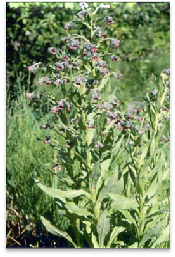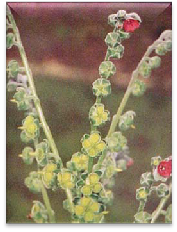Also Known As: hound’s tongue, dog bur, gypsy flower, velcro weed, rats and mice.
Houndstongue is a Class B Weed. In regions where a Class B species is already abundant, control is decided at the local level. Containment of these weeds is the primary goal so that they do not spread into uninfested regions.
Houndstongue (Cynoglossum officinale L.) is a native to Eurasia and was introduced into the United States with contaminated seed in the mid-1800s. Houndstongue is a biennial with a thick woody taproot. During its first year of growth, houndstongue appears as a leafy rosette. During the second year of growth, the coarse erect plants can reach 3’ tall becoming branched above. It commonly invades disturbed pastures, roadsides, forest edges, and meadows. Plants can often emit a musty odor. Houndstongue can be insect or self-pollinated, but cross pollination enhances seed production. Seeds are produced primarily by autogamy (self pollination). The leaves and stem are usually pubescent. The leaves are alternate, the basal, and lower ones are broad, and are oblong to lance-shaped. The upper leaves are narrower and pointed, almost clasping. The flowers are terminal, reddish-purple in color and broadly funnel- form in shape. The fruit consists of four brown nutlets (seeds), each about 1/3 inch long, with the outer surface covered with short, barbed bristles. Nutlets break apart at maturity and are rapidly scattered by animals. Over 98% of the seeds germinate in their first spring and are viable only 2-3 years. The seeds have the ability to attach to people, the coats of livestock and vehicles, enabling the plant to spread great distances. Once the seeds cling to animals, they are very hard to remove which can lower the value of wool and can cause irritation and behavioral problems in cattle.
Seed production usually varies from about 300-650 seeds per plant; however, a mature plant can produce up to 2000-6000 seeds. Seeds remaining on the soil surface can remain viable up to two years.
Houndstongue is poisonous. It contains pyrrolizidine alkaloids that cause liver cells to stop reproducing. Sheep are less susceptible than cattle or horses. Horses are especially at risk when confined to areas with houndstongue. A horse can die after eating as little as 5 mg of the toxin per kg of body weight for 3 days. Symptoms include; weight loss, photosensitization, jaundice, diarrhea, nervousness, convulsions, and coma. Animals may live up to 6 months after consuming a lethal amount.
Some clinical signs of houndstongue poisoning in cattle include:
• Slight disinterest in food
• Standing by itself, reluctant to move
• Stands with head lowered for much of the day
• Kicking at belly
• Gradual weight loss, slow to gain weight
• Diarrhea or constipation, severe straining
• Nervousness, convulsions, photosensitivity, jaundice, coma
Beneficial: (Folk remedies) Used for many disorders including, eczema, keratodermia, acne, corn callus, dermatophytosis, burns and hemorrhoids, used to keep rodents out of garden and food storage.
Control Methods
Prevention: Learn to identify plants; know your property; beware of seeds clinging to clothing or animals and of contaminated hay. Prevent the spread and establishment by using practices which reduce the spread of weeds (e.g. contain current infestations, minimize soil disturbances, detect and eradicate weed introductions early, establish competitive grasses and use proper grazing). Surface cultivation, rouging (digging, scraping, or ripping), and hand pulling can be effective if done continuously, however these practices are usually ineffective because plants are capable of regenerating from the root crown.
Cultural Control: Cultivation of young rosettes in the autumn or early spring gives effective control. Mow flowering stems close to ground to reduce seed set. Clipping during the second year flowering can greatly reduce seed production. Reseed problem areas with competitive grass species.
Mechanical Control: Mowing second year plants during flowering but before seed maturity eliminates seed production and may kill the plant.
Biological Control: (Potential):Mogulones cruciger (root weevil approved and released in Canada). Another, Longitarsus quadriguttatus (root-feeding flea beetle), has good results but may have an effect on native North American Boranginaceae.
In Europe, M. cruciger prefers large plants and may attack over 90% of those flowering. Attack reduces their seed production by about 30%. The weevil also kills over half the rosettes it attacks in the fall. The small rosettes, preferred by L. quadriguttatus, usually die by the following spring. Screening studies are continuing on a stem boring weevil, M. trisignatus, a seed weevil, M. borraginis and a root fly Cheilosia pasquorum.
Chemical Control: Picloram can provide long-term control, but this chemical is extremely mobile in water and can kill other plant species. Application of 2, 4-D amine can give up to 97% control of first year plants. Application at flowering provides much lower control of second year plants. Chlorosulfuron applied to the rosettes, and at early bolting can prevent seed production. Dicamba and Imazapic can also be used to control houndstongue infestations. Herbicide application should occur during the pre-bud or rosette stage. Pre-bud occurs in the spring or early summer and rosettes form in late summer and early fall. Surfactants (a surface-active substance) are recommended to apply with herbicides to overcome the hairiness of the leaf surface.
More information can be found in the PNW Weed Management Handbook
Use pesticides with care. Apply them only to plants, animals, or sites listed on the label. When mixing and applying pesticides, follow all label precautions to protect yourself and others around you. It is a violation of the law to disregard label directions. Store pesticides in their original containers and keep them out of the reach of children, pets, and livestock.
Questions: contact Steve Van Vleet or phone (509) 397 – 6290
Photo credits included in PDF






